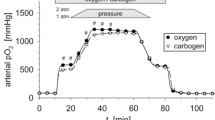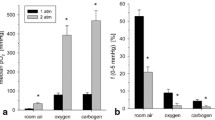Abstract
Measurement of oxygen pressure (pO2) in tumor tissue is important, because pO2 is a major factor for radiosensitivity in malignant glioma treatment. We attempted to elucidate the changes in pO2 level in glioblastoma tissue of patients under various conditions. Eighteen patients with newly diagnosed glioblastoma were recruited to this study. Disposable Clark-type electrodes were inserted using CT guided stereotactic surgery under local anesthesia and left in the intra- and peritumoral regions. pO2 was measured in patients under conditions of being awake and asleep, inhaling 100% O2, being administered osmotic diuretics and following hyperbaric oxygen exposure (HBO). Peritumoral tissue had a significantly higher pO2 value in both awake and sleeping patients. O2 inhalation could not significantly increase the pO2 level, whereas administration of osmotic diuretics induced an increase in pO2 levels in peritumoral tissue alone. The pO2 levels were significantly increased in both regions after HBO, and a high pO2 level was maintained until 15 min after HBO in both regions. It is possible that the pO2 level in peritumoral tissue is affected by intracranial pressure, whereas that in the intratumoral tissue is usually low. HBO was the optimal procedure for oxygenation, but its benefit was reduced over time.
Similar content being viewed by others
References
Dowling S, Fischer JJ, Rockwell S: Fluosol and hyperbaric oxygen as an adjunct to radiation therapy in the treatment of malignant gliomas: a pilot study. Biomater Artif Cells Immobilization Biotechnol 20: 903-905, 1992
Horsman MR: Nicotinamide and other benzamide analogs as agents for overcoming hypoxic cell radiation resistance in tumours. A review. Acta Oncol 34(5): 571-587, 1995
Kohshi K, Kinoshita Y, Terashima H, Konda N, Yokota A, Soejima T: Radiotherapy after hyperbaric oxygenation for malignant gliomas: a pilot study. J Cancer Res Clin Oncol 122: 676-678, 1996
Thomlinson RH, Gray LH: The histological structure of some human lung cancers and the possible implications for radiotherapy. Br J Cancer 9: 539-549, 1995
Chang CH: Hyperbaric oxygen and radiation therapy in the management of glioblastoma. Natl Cancer Inst Monogr 46: 163-169, 1977
Kohshi K, Kinoshita Y, Imada H, Kunugita N, Abe H, Terashima H, Tokui N, Uemura S: Effects of radiotherapy after hyperbaric oxygenation on malignant gliomas. Br J Cancer 80: 236-241, 1999
Collingridge DR, Piepmeier JM, Rockwell S, Knisely JP: Polarographic measurements of oxygen tension in human glioma and surrounding peritumoural brain tissue. Radiother Oncol 53: 127-131, 1999
Kayama T, Yoshimoto T, Fujimoto S, Sakurai Y: Intratumoral oxygen pressure in malignant brain tumor. J Neurosurg 74: 55-59, 1991
Moriglane JR: Measurement of oxygen partial pressure in brain tumors under stereotactic conditions. Adv Exp Med Biol 345: 471-477, 1994
Rampling R, Cruickshank G, Lewis AD, Fitzsimmons SA, Workman P: Direct measurement of pO2 distribution and bioreductive enzymes in human malignant brain tumors. Int J Radiat Oncol Biol Phys 29: 427-431, 1994
Clark LC Jr: Monitor and control of blood and tissue oxygen tensions. Trans Amer Soc Art Int 2: 41-46, 1956
Tanaka M, Hanioka T, Takaya K, Shizukuishi S: Association of oxygen tension in human periodontal pockets with gingival inflammation. J Periodontol 69: 1127-1130, 1998
Okubo J, Watanabe K, Harada H, Teramura K, Koyama S, Ishikawa N, Ogawa A, Hanari K, Watanabe I: O2 tension changes in the tympanic cavity and role of the capillary structure in human mastoid cells (in Japanese). Jibirinsho 80: 1521-1527, 1987
Brown JM: Evidence for acutely hypoxic cells in mouse tumours, and a possible mechanism of reoxygenation. Brit J Radiol 52: 650-656, 1979
Cruickshank GS, Rampling R: Does tumour related oedema contribute to the hypoxic fraction of human brain tumoursč Acta Neurochir (Wien) 60: 378-380, 1994
Chaplin DJ, Durand RE, Olove PL: Acute hypoxia in tumours: implication for modifiers of radiation effects. Int J Radiat Oncol Biol Phys 12: 1279-1282, 1986
Gray LH, Cogner AD, Ebert M, Hornsey S, Scott OCA: The concentration of oxygen dissolved in tissues at the time of irradiation as a factor in radiotherapy. Br J Radiol 26: 638-648, 1953
Kalns JE, Piepmeier EH: Exposure to hyperbaric oxygen induces cell cycle perturbation in prostate cancer cells. In Vitro Cell Dev Biol Anim 35: 98-101, 1999
Haffty BG, Hurley RA, Peters LG: Carcinoma of the larynx treated with hypofractionated radiation and hyperbaric oxygen: long-term tumor control and complications. Int J Radiat Oncol Biol Phys 45: 13-20, 1999
Haffty BG, Hurley R, Peters LJ: Radiation therapy with hyperbaric oxygen at 4 atmospheres pressure in the management of squamous cell carcinoma of the head and neck: results of a randomized clinical trial. Cancer J Sci Am 5: 341-347, 1999
Voute PA, van der Kleij AJ, De Kraker J, Hoefnagel CA, Teil-van Buul MM, Van Gennip H: Clinical experience with radiation enhancement by hyperbaric oxygen in children with recurrent neuroblastoma stage IV. Eur J Cancer 31: 596-600, 1995
Saunders M, Dische S: Clinical results of hypoxic cell radiosensitization from hyperbaric oxygen to accelerated radiotherapy, carbogen and nicotinamide. Br J Cancer 74(Suppl. XXVII): 271-278, 1996
Kinoshita Y, Kohshi K, Kunugita N, Tosaki T, Yokota A: Preservation of tumour oxygen after hyperbaric oxygenation monitored by magnetic resonance imaging. Br J Cancer 82: 88-92, 2000
Jamieson D, van den Brenk HAS: Measurement of oxygen tensions in cerebral tissues of rats exposed to high pressures of oxygen. J Appl Physiol 18: 869-876, 1963
Author information
Authors and Affiliations
Rights and permissions
About this article
Cite this article
Beppu, T., Kamada, K., Yoshida, Y. et al. Change of Oxygen Pressure in Glioblastoma Tissue Under Various Conditions. J Neurooncol 58, 47–52 (2002). https://doi.org/10.1023/A:1015832726054
Issue Date:
DOI: https://doi.org/10.1023/A:1015832726054




